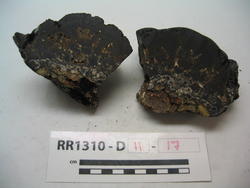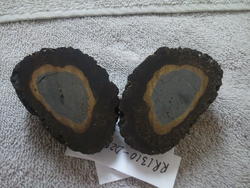Here on research cruise RR1310 (R/V Roger Revelle, Year 2013, Expedition 10) our goal is to chip away at undersea volcanoes with the hopes of picking up good chunks of pillow lavas or other lava flows into our dredge net. However, much of the material on seamount flanks is not actually volcanic rock but of a sedimentary nature. Beside limestone and coral debris we also find manganese-rich encrustments and Mn-nodules, which both are a product of iron and manganese mineralization out of the water column that forms hard oxide minerals. Here we will discuss how these thick rock-like structures form and what they reveal about chemical dynamics on the deep-sea floor.
In order to find outcrops of basalt, we use an EM122 multibeam echosounder. We rely on the relief of a seamount's flank and the intensity of the returned sonar signal to identify suitable dredge targets (for a description of our dredging process see our previous blog). The intensity of the return signal is dependent on the structure of the material on the ocean floor. The sound waves received back from sediment will be scattered and weak, whereas basalt will return a stronger signal. Through a combination of the relief of the seamount and the intensity of the signal returned, a decision is made about whether or not we are looking at a basalt outcrop. But there are other materials on the sea floor that can return strong signals: manganese crust and coral. Coral is present at shallower depths and will be discussed in a separate blog post. The other material is a deposit called manganese or ferromanganese crust (we’ll refer to these as Mn-crust). Mn-crust strongly reflects sound waves, similar to basalts. This makes finding exposed basalt challenging. The generation of Mn-crust is quite interesting and reflects the amount of element cycling and fluid movement that occurs near volcanic centers on the deep-sea floor and in ocean water.
Mn-crust is a metal-rich material that is hydrogenous (derived from water) and that is formed by the precipitation of metals derived mainly from seawater. Over time Mn-crust builds up thick rinds on basalt outcrops (Figure 1). It can also form small nodules (Figure 2) by using any solid material as a nucleus for growth (e.g. basalt or fish bones). The formation process begins when seawater is sucked into the ocean crust where basalt is exposed, by sticking out above the thick blanket of seafloor sediments. There, seawater starts to circulate through the basaltic crust and is then ejected out through hydrothermal vents. Basalt is relatively porous compared to the thick, compacted sedimentary layers that lay as a blanket on the flat ocean floor that are surrounding the seamounts and mid-ocean ridges. As a result seawater preferentially will flow through the basaltic ocean crust. As seawater circulates through newly generated oceanic crust it heats up and leaches out heavy metals such as manganese, iron, nickel, copper, cobalt and rare earth elements (e.g. tellurium, niobium and thorium). The concentration of Mn and these other elements in the crust are 10 to 1,000 times higher than continental abundances. Rare-earth elements such as tellurium are especially valuable due to their use in modern day electronics. Thick crusts accumulate near areas of high magmatic fluid flow, whereas manganese nodules form more slowly and generally where there is less fluid flow. There have been successful efforts to use these deep-sea nodules as records of the changing composition of seawater over time, since they have been found to grow only millimeters every million years (deep-sea environments). Crusts formed near hydrothermal deposits can form rapidly at >1,000 millimeters per million years.
Not all is lost if we pull up a dredge full of Mn-crust since it generally forms on top of basalt. Underneath the thick Mn-crust carapace there could be relatively fresh (Figure 2) and/or altered basalt (Figure 1). The occurrence of Mn-crust and nodules has been known about since the Challenger Expedition in the 1872-1876 and has been of great interest to the scientific community due to the high abundance of metals and rare earth elements in the crusts. There are serious efforts underway to mine Mn-crust off the ocean floor, but these operations have extremely high costs and could have serious environmental impacts.
by Daniel Heaton
- 8510 reads

